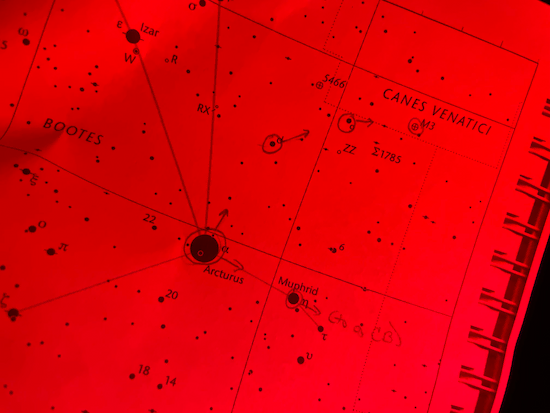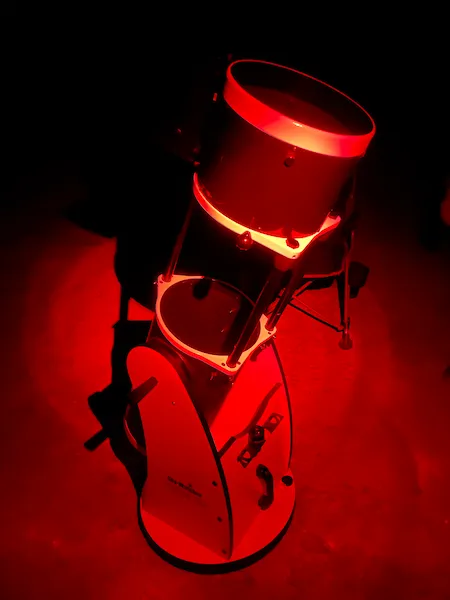I almost skipped this one. I’d been running on fumes all week, chasing too many projects. My plan to sleep in? Foiled by the neighbor’s lawn service.
I kind of hoped the clouds would roll in and give me a guilt-free out. But no. The sky was crystal clear.
At least I remembered the mosquito problem—and I was sure I had an old bottle of natural repellent somewhere. A desperate and thorough last-minute search proved me wrong.
So I dragged my bleary-eyed, mosquito-bait self out to the fairgrounds, promising myself I’d stay just long enough to see what was what.
First Impressions: Low Turnout, High Wholesomeness
When I pulled in, the parking lot was nearly empty. I forgot it’s Memorial Day weekend. Probably the reason for the low turn-out. The only car there had its lights still on—my first clue this was not an experienced astronomer.
It turned out to be the loveliest couple, Tom and Betsy, who had never been to a meeting or event before. No telescope, no gear—just curiosity and wonder. I parked next to them and we got to chatting.
Thankfully it wasn’t long before Carol arrived with a telescope and binoculars in tow. I hadn’t met her before either, but she instantly became our MVP of the night.
The Sky Tonight: Jupiter, Double Stars, and a Smudge of a Galaxy
The sky was clear at first, with thin clouds drifting in and out later. Jupiter was the first big sight—low on the horizon and just about to set. Tom and Betsy spotted it through binoculars and were blown away. I couldn’t wait for them to see it through the telescope.
Other sights included:
- The double star in the Big Dipper’s handle (Alcor and Mizar)
- The Whirlpool Galaxy (M51) – just a faint smudge, easier to see with averted vision
- Later, we attempted to locate M3, a globular cluster—but had no luck
Carol also taught me a ton—about sky maps, how reflector telescopes flip the image, and something I’d never heard of before: star-hopping.
It’s a method for finding deep-sky objects manually by using familiar stars as stepping stones. For M3, she had a printed star chart (pictured below) and walked me through how to trace a path from visible stars to our target.

She explained that, for the object she was looking for that night, the Big Dipper’s handle helped point the way. Its arc curves down toward Arcturus, one of the brightest stars in the sky. From there, she “hopped” from one reference point to the next, using the chart to close in on the cluster.
Depending on what you’re trying to find, though, star-hopping starts from different bright stars—whatever’s visible and useful as a guide in that part of the sky.
Even though we didn’t manage to spot M3, it was my first real look at how analog sky navigation works—and it made the whole process feel a little less intimidating.
Unexpected Highlights
One of the best parts of the night wasn’t even overhead—it was the lightning storm flickering off in the distance. We kept turning to watch it light up the horizon, and it somehow didn’t take away from the stars at all. It just added to the feeling that the whole sky was putting on a show.
Also: I finally remembered to take pictures! The photo up top? That’s Carol’s telescope in action. She kept apologizing that it was not as high-quality as some other members who are usually present, but it was fine for us noobs. Certainly better than nothing!
Reflections & Resources
This time around, I felt way more confident than I did at my first star party. At first, I was the most experienced one there, and it felt good to share what I knew. Carol later became the real guide of the night, and she was incredibly generous with her time—even if she repeatedly apologized for “not being a real educator.” (She did great.)
She introduced me to a few tools and resources I’ve since added to my Amazon wishlist. If you’re curious, here are links to the same ones she showed me (with my affiliate code):
The books are on the pricey side—especially the atlas. There’s a cheaper Kindle version, but I’m not sure how practical that would be when you’re outside under the stars.
Fortunately, there’s also a great free option: Skymaps.com, which offers downloadable PDFs each month. Carol said it’s a great way to get started while you’re saving up or still deciding if you want to invest in a physical book.
As for the laser pointer, it’s the same brand Carol uses—because our club president Paul uses it too. There are definitely cheaper versions online, so I might ask Paul if there’s a reason he swears by this one.
Final Notes
Tom and Betsy stayed for an hour or so. I hung around a bit longer—just me and Carol by the end. It wasn’t a big crowd, but it turned into something really special—quiet, personal, and highly educational. It’s wild how much you can learn in just a couple hours under the stars.
I showed up exhausted. I left inspired—and officially hooked on star-hopping. Definitely a night I’ll remember, I’m glad I dragged myself out after all.
And yes, I did get a little chewed up by mosquitoes again. Worth it.


Your write-up makes me wish I would have gone. The star hopping lesson would have been great. I have never been good finding my way around in the night sky because everything KEEPS MOVING!😆
Haha I know, right? It was very helpful!
AJ, I’m so glad you told us about your blog at tonight’s club meeting. Love it! I’ve already read each one and look forward to following your journey.
Aw thx so much, Don! And thx for bringing that awesome scope out to my first star party. I wish I’d remembered to snap a picture of it — hope you’ll bring it out again!